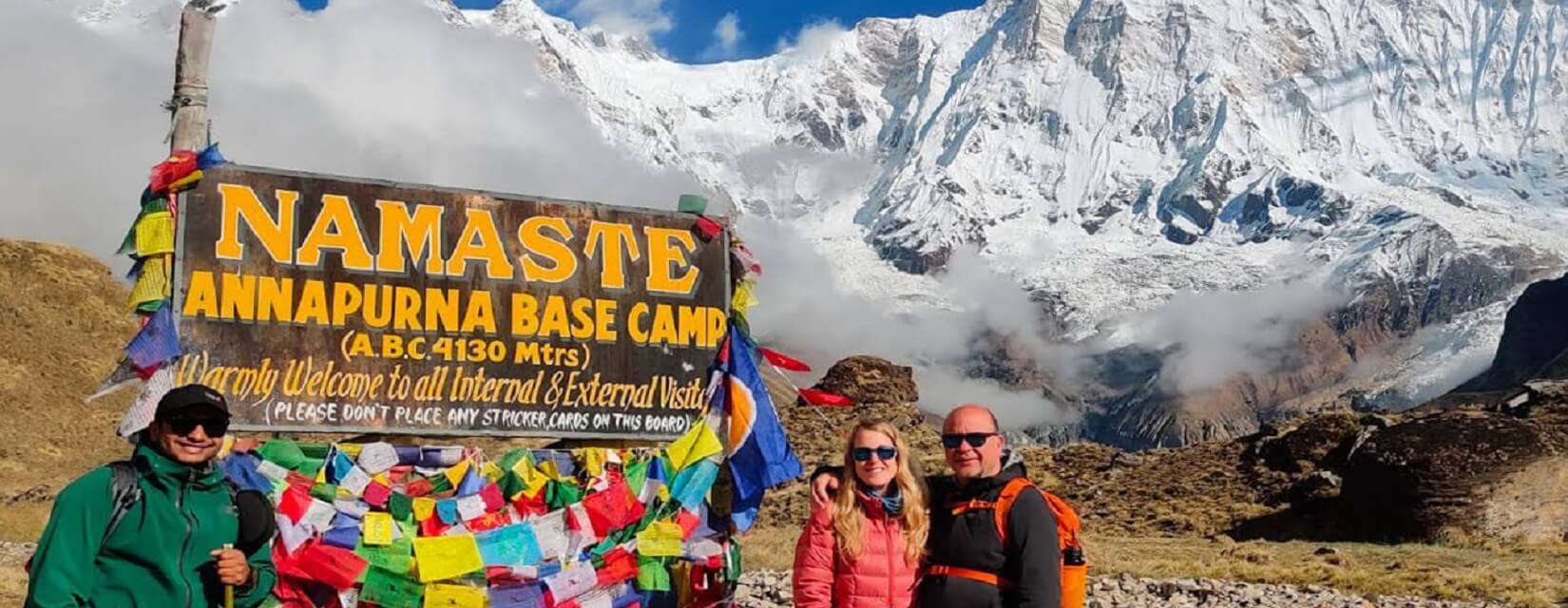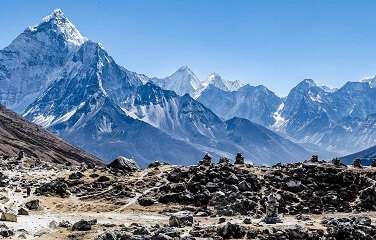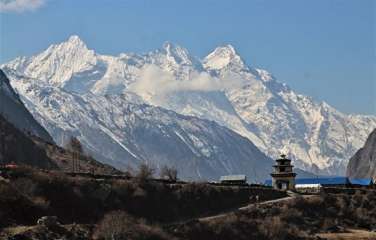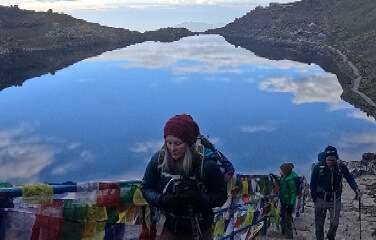Physical Preparation and Fitness
.jpg)
While the Annapurna Base Camp trek is moderate compared to more technical treks like Everest Base Camp or Island Peak, it still demands a good level of fitness. The terrain involves long ascents and descents, often on uneven stairs and rocky trails. You will be walking for 5 to 7 hours daily, covering 10 to 15 kilometers.
Key fitness tips:
- Cardio training: Engage in cardio exercises like running, cycling, or swimming 3-5 times a week to build your stamina. Hiking with a loaded backpack will better prepare your body for the actual trek.
- Leg and core strength: Strengthening your legs and core is crucial. Exercises like lunges, squats, and planks will help you cope with steep inclines and descents.
- Hiking practice: Try to hike on similar terrain before the trek. Gradually increase the weight of your backpack to simulate the trek’s demands.
- Endurance training: Ensure you can sustain a steady pace over 5-7 hours without fatigue. Multiday hikes can be useful for this.
Altitude Acclimatization
One of the most challenging aspects of the ABC trek is acclimatization to high altitudes. Although altitude sickness is less common on the Annapurna Base Camp trek compared to other high-altitude treks, it is still essential to be cautious, especially after reaching over 3,000 meters.
Key altitude tips:
- Take it slow: Avoid rushing through the trail. Your body needs time to adapt to lower oxygen levels at higher altitudes.
- Stay hydrated: Drink plenty of water (3-4 liters daily) to combat dehydration, which can exacerbate altitude sickness.
- Climb high, sleep low: If possible, gain some extra elevation during the day but descend a little before sleeping.
- Acclimatization days: Plan acclimatization days at key points like Chhomrong or Dovan to help your body adjust.
- Watch for symptoms: Be aware of early symptoms of Acute Mountain Sickness (AMS), including headaches, nausea, dizziness, and shortness of breath. If symptoms worsen, descend immediately.
Essential Gear and Packing List

Packing the right gear is essential for a successful trek. ABC can be warm in the lower altitudes and quite cold near base camp, so layering your clothing is important.
Essential gear:
- Clothing:
- Base layers: Lightweight moisture-wicking layers for trekking during the day.
- Insulation: A good fleece or down jacket to keep warm in the evening and at higher altitudes.
- Waterproof jacket and pants: Weather in the mountains can change suddenly, so pack a high-quality waterproof outer layer.
- Trekking pants: Comfortable, durable trekking pants.
- Hat, gloves, and scarf: Protection from cold winds and sun at higher elevations.
- Footwear:
- Trekking boots: Waterproof, broken-in boots with good ankle support.
- Trekking socks: Wool or synthetic socks to keep your feet dry and blister-free.
- Other gear:
- Backpack: A 40-50L pack for your essentials, with a rain cover.
- Sleeping bag: A four-season sleeping bag rated for at least -10°C (14°F).
- Trekking poles: Useful for stability on uneven terrain and during long descents.
- Water bottle or hydration system: Carry a reusable water bottle or hydration bladder, along with water purification tablets or a filter.
- Sunglasses and sunscreen: High UV protection is essential for trekking at altitude.
- Headlamp: Handy for early starts or walking after dusk.
Trekking Permits
To trek to Annapurna Base Camp, you will need two essential permits:
- Annapurna Conservation Area Permit (ACAP): This is required for entering the Annapurna region.
- Trekkers' Information Management System (TIMS) card: This helps track trekkers in the region for safety.
Both permits can be obtained in Kathmandu or Pokhara from the Nepal Tourism Board offices.
Guides and Porters

First-time trekkers, especially those unfamiliar with the terrain, might want to hire a guide or porter. A licensed guide can offer valuable information about the culture, environment, and safety, while a porter can carry your heavy gear, allowing you to enjoy the trek without being overly burdened.
Why hire a guide/porter?
- Safety and navigation: Guides know the region well and can help you avoid getting lost, especially in remote areas.
- Local knowledge: They can provide insights into the villages, traditions, and wildlife you’ll encounter.
- Supporting local economy: Hiring guides and porters provides jobs for locals, contributing to the economy of the region.
Best Time to Trek
The best times to trek to Annapurna Base Camp are in spring (March to May) and autumn (September to November). During these seasons, the weather is relatively stable, and the skies are clear, providing excellent mountain views.
- Spring (March-May): The rhododendron forests are in full bloom, adding color to the landscape. The temperatures are mild, and the trails are not too crowded.
- Autumn (September-November): The skies are clear after the monsoon rains, and the weather is ideal for trekking, although the trails can be more crowded.
Budget Considerations
Trekking to Annapurna Base Camp is affordable compared to other treks in the region, but it’s essential to budget properly to ensure a comfortable experience.
Typical expenses:
- Accommodation: Expect to pay between $5-$10 per night for a basic teahouse, but prices increase at higher altitudes.
- Meals: Meals range from $5 to $15 depending on altitude and availability. Dal Bhat (a traditional Nepali dish) is commonly available and offers excellent energy.
- Guide/porter fees: A guide can cost $20-$30 per day, and a porter around $15-$20 per day.
- Permits: ACAP and TIMS cards will cost around $40-$50 combined.
Trekking Etiquette and Cultural Considerations

Nepalese people are incredibly hospitable, and it’s important to respect their customs. Here are a few cultural tips to keep in mind:
- Respect local customs: Always ask before taking photos of locals, and be mindful of religious sites.
- Be eco-conscious: Use refillable water bottles to avoid plastic waste, and leave no trace on the trails.
- Support local businesses: Buy food and supplies from local teahouses and shops to help support the local economy.
Mental Preparation
The ABC trek, like any trek, requires mental resilience. Trekking for several days, facing physical fatigue, and sometimes dealing with uncertain weather can challenge your mental strength. Staying positive, pacing yourself, and embracing the journey with flexibility will make the trek more rewarding.
Emergency Preparedness
Though relatively safe, it’s essential to be prepared for emergencies:
- Travel insurance: Ensure you have travel insurance that covers trekking up to 4,130 meters, helicopter evacuation, and medical emergencies.
- First-aid kit: Carry basic first-aid supplies, including altitude sickness medication like Diamox, blister treatments, and pain relievers.
Accommodations and Food Along the Trek
One of the advantages of trekking in the Annapurna region is the availability of well-established teahouses. These basic lodges provide food and shelter, making it unnecessary to carry camping gear unless you prefer a more rugged experience.
Accommodations:
- Teahouses: Typically, rooms are shared or private with twin beds, and bathrooms are communal. At lower altitudes, you may find more comfortable options, but as you ascend, facilities become more basic.
- Showers: Hot showers are available in most teahouses, though the higher you go, the more expensive they become (usually ranging from $2 to $5).
- Electricity and charging: Electricity is available in most teahouses, but charging electronic devices can incur additional fees. Carry a portable power bank to avoid dependency on charging stations.
Food: Teahouses offer a simple but filling menu, often centered around traditional Nepali meals and basic Western dishes.
Common dishes include:
- Dal Bhat: The most popular Nepali dish, consisting of rice, lentil soup, vegetable curry, and pickles. It’s all-you-can-eat, which makes it an excellent energy source for trekkers.
- Momos: Nepalese dumplings filled with vegetables or meat, served steamed or fried.
- Noodles, pasta, and soups: These are common options, particularly at higher altitudes.
- Pancakes, omelets, and porridge: Breakfast choices often include pancakes, omelets, or porridge.
- Snacks: Carry your own high-energy snacks like nuts, chocolate, or energy bars as a supplement to meals on the trek.
Weather Considerations
.jpg)
The weather on the Annapurna Base Camp trek can vary significantly depending on the time of year and altitude.
- Spring (March-May): Expect warm temperatures at lower altitudes (up to 25°C/77°F during the day), but cooler temperatures as you ascend (down to -5°C/23°F at night near Base Camp). Rhododendron forests will be in full bloom, adding vibrant colors to the landscape.
- Autumn (September-November): The post-monsoon season offers clear skies, ideal for mountain views. Temperatures are moderate at lower altitudes, while higher up, it can be freezing at night. Expect daytime temperatures ranging from 15°C to 20°C (59°F to 68°F), with nighttime temperatures dipping below freezing at Base Camp.
- Winter (December-February): While trekking is still possible, winter brings cold weather, especially above 3,000 meters, where temperatures can fall as low as -10°C to -15°C (14°F to 5°F). Snowfall may block the route to Base Camp, and teahouses at higher altitudes may close.
- Monsoon (June-August): The trail becomes wet and muddy during the monsoon season, and leeches are common in the forests. Clouds often obscure mountain views, and the risk of landslides increases. Trekking during this time is less popular, but if you don't mind the rain and want to avoid crowds, it’s still possible.
Health and Safety Tips
Ensuring your health and safety on the trail is vital, especially for first-time trekkers. Here are some critical health and safety considerations:
- Altitude sickness prevention: Take altitude sickness seriously, and always ascend gradually. If symptoms of AMS (headache, nausea, dizziness) persist, descend immediately.
- Hydration: Stay hydrated, as dehydration can exacerbate altitude sickness. Purify water using tablets or a filter, as bottled water is expensive and contributes to plastic waste.
- Nutrition: Eat carbohydrate-rich meals to maintain your energy levels. Dal Bhat, in particular, is an excellent source of sustained energy.
- Personal hygiene: Keep hand sanitizer handy, as hot water and soap may not always be available. Bring personal wipes for a quick clean-up after a long day of trekking.
- Foot care: Take care of your feet by wearing moisture-wicking socks and properly fitting boots. Treat blisters early to avoid discomfort during long days of hiking.
Mental Preparedness
Your mental attitude is just as important as physical preparation when trekking to Annapurna Base Camp. Here are some tips to prepare mentally:
- Stay positive: Trekking can be physically exhausting, especially for first-time trekkers. A positive mindset will help you push through difficult moments, whether it's fatigue, challenging weather, or altitude.
- Embrace flexibility: The unpredictable nature of mountain weather can disrupt your plans. Being adaptable and flexible with your itinerary will make the experience more enjoyable.
- Break down your trek into stages: Instead of focusing on the full trek, break it down into daily goals or specific landmarks. This helps reduce the mental burden and gives you a sense of accomplishment each day.
Environmental Impact and Responsible Trekking
As one of the most visited trekking regions in Nepal, the Annapurna region is vulnerable to environmental damage from tourism. As a responsible trekker, follow these guidelines:
- Carry out your trash: Avoid leaving litter on the trails. Many villages do not have proper waste disposal systems, so pack out all trash, including plastic packaging.
- Avoid plastic water bottles: Use a reusable water bottle and purify water using tablets or filters. Buying plastic water bottles contributes to pollution and is expensive at higher altitudes.
- Respect wildlife: Do not disturb or feed wildlife. Respect local flora and fauna by staying on marked trails.
- Cultural respect: Be mindful of local customs, traditions, and religious sites. Always ask for permission before photographing people or their homes, and dress modestly in villages.
Travel Insurance
Trekking insurance is essential, particularly for treks that take you above 4,000 meters. Ensure that your travel insurance covers:
- High-altitude trekking: Confirm that your policy covers trekking at least up to 4,130 meters (the height of Annapurna Base Camp).
- Helicopter evacuation: In case of altitude sickness or injury, helicopter evacuation is often necessary in remote areas.
- Medical coverage: Ensure that medical expenses are covered, including hospital stays and emergency treatments in Nepal.
Additional Tips for First-Time Trekkers
- Start early each day: Begin your trekking days early to avoid afternoon weather changes like rain or cloud cover. Mornings generally offer clearer skies and better views of the mountains.
- Pace yourself: Walk at a comfortable pace, and don’t be afraid to take breaks. Overexertion can lead to fatigue or increase the risk of altitude sickness.
- Stay informed about the trail: Ask guides, fellow trekkers, or teahouse owners about trail conditions, weather updates, and best routes to take.
- Interact with locals: Engaging with local villagers and teahouse owners enriches the trekking experience and offers insight into the Himalayan culture.
Post-Trek Recovery

After completing your trek to Annapurna Base Camp, it’s important to allow your body to recover. Here’s how to care for yourself post-trek:
- Rest and relax: Take a couple of days in Pokhara or Kathmandu to rest. Your muscles and joints will need time to recover after days of hiking.
- Hydrate and refuel: Continue to hydrate and eat nutritious meals to replenish the energy you expended during the trek.
- Massage and stretching: Consider getting a massage or doing light stretching or yoga to relieve any muscle soreness.
With the right preparation, the Annapurna Base Camp trek can be an unforgettable adventure, offering stunning mountain vistas and a deep connection to Nepal’s rich cultural and natural heritage. For first-time trekkers, this journey can serve as a stepping stone into the world of high-altitude trekking, leaving you eager for more.
Related Packages in the Annapurna Region





